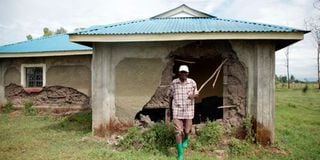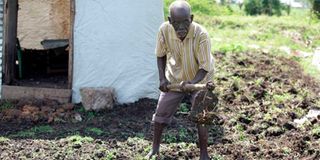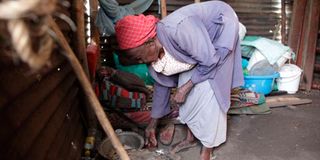Premium
Climate change: Trail of destruction, misery as Lake Victoria reacts

For close to three years now, 65-year-old Nelson Onyango Abuor has helplessly been watching his seven-acre piece of land getting swallowed as Mother Nature reared its ugly head in front of him.
So devastating has the situation been for the retired assistant chief of Ogenya sub-location in Nyando Sub County.
“The rise in Lake Victoria water levels which started in 2019 happened so fast,” said the former administrator as he blankly gazed at his wasted ancestral land.
Experts have attributed the bulge of Lake Victoria to effects of climate change, which has affected the rain cycles, as well as poor or no environmental conservation practices in the daily lives of people living along the shores of the transboundary water body.
While having only one outlet through river Nile in Jinja, Uganda, some of the rivers feeding Lake Victoria originate from as far as Rwanda and Burundi.
The bursting of river Nyando banks has also contributed to the worst backflow that steadily rose to peak at 13.45 metres, according to a survey conducted by Lake Victoria Basin Commission.

Mr Platinus Miruka 80, digs outside his makeshift house at Nduru Village in Nyando, Kisumu County on April 22, 2021.
At the height of the disaster, Kanyagwal Location chief Boniface Nyandeje pointed out that about 864 households were displaced as water surged up to four kilometres from the landing site, a move that saw a total of 1,600 acres getting submerged in the area.
Apart from his five-roomed retirement home getting underwater, the aftermath of the raging waters saw Mr Abuor lose his crops, livestock and other household items.
“It is sad seeing the home which I built using my pension submerged in the water,” he told Nation.Africa.
He noted as painful that he has nothing to show for the 36 years he worked as an adult education teacher, with 21 years being in the administration.
“I invested all my life savings on my farm and my home. All this has gone down the drain,” Mr Abuor said.
He was forced to rent a single iron-sheet room at a higher ground in Riat shopping centre where he lives with his wife and six grandchildren.
From a life of providing for himself and his extended family, the former administrator has had to rely on well-wishers and donors for upkeep.
After squeezing together for one and a half years, Mr Abuor was elated when one of the residents offered him a piece of land in the neighbourhood to build a house.
“With the help of friends and other well-wishers, I managed to build a two-roomed house and have a small space where I can do peasant farming,” he said.
A few kilometers away, 85-year-old Wilfrida Okoth is also facing the same predicament after the destruction of her house and loss of her entire property.
Raging river Nyando
The lonely woman who lives in a tiny iron sheet structure was forced out of her home after her belongings were carried to the lake by the raging river Nyando after it broke its bank following the massive effects of the torrential rains.
Inside the house, her few households are piled in one corner, leaving a small area where she has placed her beddings on the floor and a space for cooking using firewood.
“This has been my home for the last two years. We are just praying for a miracle that the water will subside and restore our lives,” said the old woman who has moved from Ogenya to the neighbouring Kakola sub location.
The adverse effects of climate change has also left thousands of other residents still living in makeshift tents, hoping the level of Lake Victoria waters will subside.
To date, Ogenya assistant Chief Barnabas Odhong' has indicated that 350 families are still living in camps, rented houses or integrated with families and relatives who live in dry areas.

Wilfridah Okoth, 84, at her makeshift house at Nduru Village in Nyando, Kisumu County on April 22, 2021.
Mr Nyandeje noted that the prolonged effects of flooding has affected some of the critical facilities like health facilities, markets, beaches and six other primary and secondary schools in the expansive region.
Other schools that stretch to South Kawino Location in Nyando include Nyamrundu, Oseth, Kibarwa, Odienya Korwana and both Kandaria primary and secondary schools.
“We had to merge some schools with the neighbouring ones after they were rendered inhabitable,” he said.
Other than the risk of human-wildlife conflict, the prevailing condition has seen a sharp increase of diseases like malaria and other waterborne ailments.





